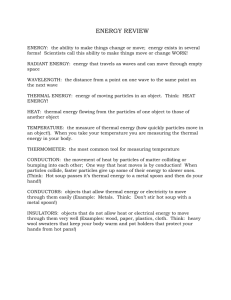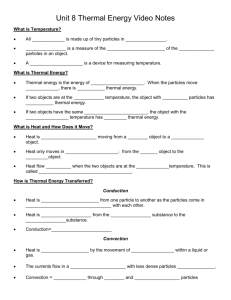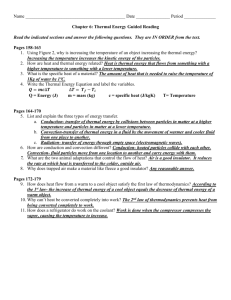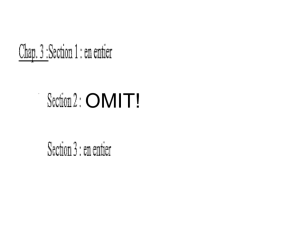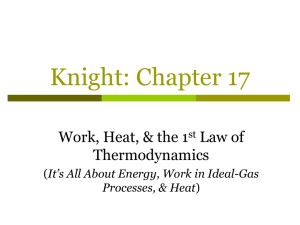Thermodynamics_AP
advertisement
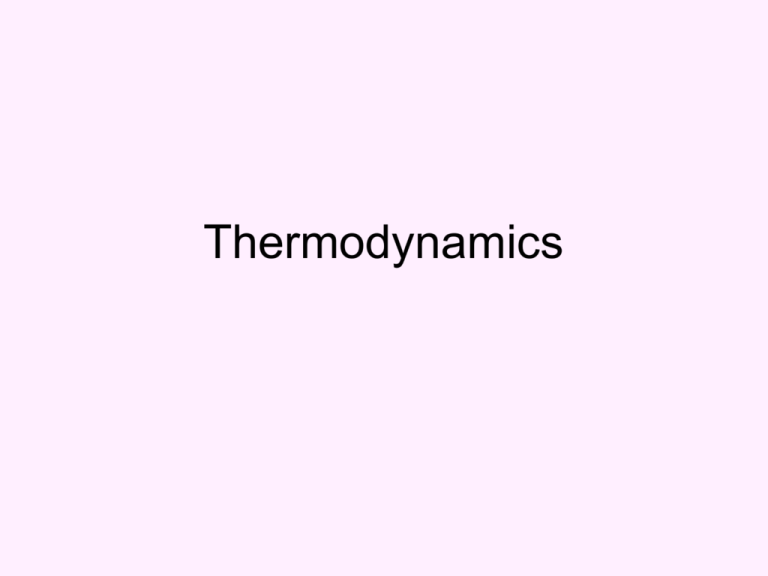
Thermodynamics The Ideal Gas Law Assumptions • The particles of a gas (atoms or molecules) obey Newton’s laws. • Particles in the gas move with a range of speeds • The volume of the individual gas particles is negligible compared to the volume of the gas. • The collisions between the particles and the walls of the container and between the particles themselves are elastic (no kinetic energy lost) • There are no forces between the particles (except when colliding). This means that the particles only have kinetic energy (no potential) • The duration of a collision is small compared to the time between collisions. • The temperature is directly proportional to the average kinetic energy of the gas particles. • One mole of an ideal gas contains 6.02x1023 particles and occupies 22.4dm3(L) at Standard Temperature Pressure. (STP T=0ºC and P=1.01x105Pa.) Pressure – A reminder Pressure is defined as the normal (perpendiculr) force per unit area P = F/A It is measured in Pascals, Pa (N.m-2) Ideal Gas Law Equation PV nRT P = Pressure (N/m2 = Pa) V = Volume n = # of moles R = Universal Gas Constant (8.31Jmol-1K-1) T = Temperature (K) simulation Graphical relationships between pressure, volume and temperature. Constant Constant Constant Temperature Volume Pressure P P V V T T Combined Gas Law PV nRT PV nR constant T P1V1 P2V2 T1 T2 Example 1: The internal volume of a gas cylinder is 3.0x10-2 m3. An ideal gas is pumped into the cylinder until the pressure is 15MPa at a temperature of 25ºC. a) Determine the number of moles of the gas in the cylinder b) Determine the number of gas atoms in the cylinder? c) Determine the average volume occupied by one atom of the gas. d) Estimate the average separation of the gas atoms. Example 2: A sample of gas is contained in a vessel at 20ºC at a pressure P. What temperature does the gas need to be heated to in order for the pressure of the gas to be doubled if the volume remains constant? Work done on a gas(system) by a piston. Gas Gas V2 V1 A Force F P A F P(A) Δx W Fx P( A) x P( V ) The First Law of Thermodynamics • The study of processes in which thermal energy is transferred as heat and work. • Applies to engines that convert thermal energy to mechanical energy. • Macroscopic view of pressure, volume, temperature and internal energy in determining the state of a system. ΔU ↑ System System Q=Thermal Energy (Heat) Engine Engine WORK (piston) (piston) Q W U Q W ΔU = The change in internal Energy, which is an increase in temperature of the System. First Law of Thermodynamics U Q W U Q PV All quantities are measured in joules. Statement of conservation of ENERGY Q = Heat added to system/gas (+) or removed from system/gas (-) W = Work done on system/gas (+) or Work done by system/gas (-). Work is done when there is a change in volume. ΔU = increase in internal energy (+) or decrease in internal energy (-). ΔU represents a temperature change. Specific Processes and their corresponding PV graphs • Isobaric Process – Pressure remains constant and work is done on the system (-ΔV) or by the system (+ΔV). • Isochoric (isovolumetric) Process - Volume remains constant. No work is done, so there must be a change in internal energy. • Isothermal Process – Temperature is constant and the pressure and volume vary inversely. • Adiabatic Process – No thermal energy is added or removed from the system. (Q=0) Process Definition isobaric constant pressure PV diagram P W W=PΔV V isochoric constant volume P W=0 V isothermal constant temperature P W=? V no heat added or taken away (ΔU = W) P adiabatic V Heat Engine P C D DA B CB A V simulation Heat Engine • Net work is done by the gas • Cycle is clockwise Heat Pump or Refrigerator • Net work is done on the gas • Cycle is counterclockwise. Efficiency W Qh Qc e Qh Qh Qh = Input Heat (Joules) Qc = Exhaust Heat (Joules) W = Work (J) Maximum Efficiency – Carnot Cycle Th Tc ec Th Th = Maximum temperature in Kelvin Tc = Minimum temperature in Kelvin Example: (a) For part A→B of the cycle, explain whether (i) Work is done by the gas or work is done on the gas. (ii) Thermal energy (heat is absorbed by the gas or is ejected from the gas to the surroundings. (b) Calculate the work done during the change A→B. (c) Use the graph to estimate the total work done during one cycle. (d) The total thermal energy supplied to the gas during one cycle is 120kJ. Estimate the efficiency of this heat engine.
